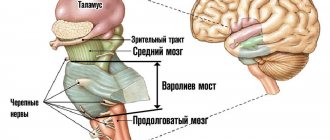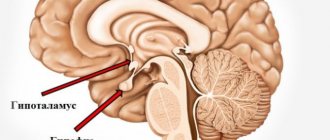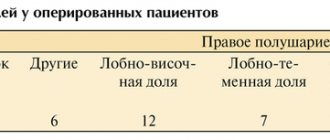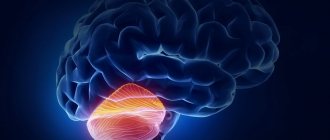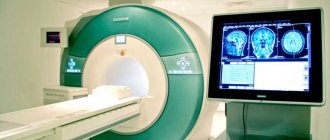Serotonin molecule
The pineal gland (pineal gland) is a tiny cerebral process that belongs to the central endocrine system.
The main hormones of the pineal gland are serotonin and melatonin. These active substances play a leading role in regulating a person’s circadian rhythms and restoring the body during sleep. They also affect the function of the pituitary gland, thyroid gland, adrenal glands, gonads, pancreas (insulin production), nervous system function and emotional state.
The other two hormones are less well known. Adrenoglomerulotropin regulates kidney function, and dimethyltryptamine (DMT) regulates the emotional and mental sphere.
Serotonin
The main regulator of sleep and wakefulness processes. It is produced only during daylight hours under the influence of ultraviolet radiation. Refers to neurotransmitters and tissue hormones. This means that it is involved in the conduction of nerve impulses, but also “works” in tissues and organs.
The mechanism of action of serotonin
Serotonin as a neurotransmitter
It is sometimes called the hormone of joy, but this is not entirely true. Dopamine is largely responsible for the emotions of joy, while serotonin rather suppresses the center of negative emotions, preventing the development of depression.
In addition, it reduces sensitivity to pain. People with a high pain threshold have fairly high levels of serotonin and many serotonin receptors.
It has an inhibitory effect on the nervous system - this is due to its anti-stress and general calming effect.
Serotonin is important for blocking weak sensory signals so that the mind does not “hear” distracting sounds, and a person can focus on tasks that are important to him.
Together with dopamine, serotonin is involved in the regulation of the hypothalamic-pituitary system, stimulating the production of prolactin and other pituitary hormones.
Serotonin as a tissue hormone
The tissues contain a large amount of serotonin and receptors for it. It affects blood vessels, the digestive system, smooth muscles, and immunity.
Serotonin constricts blood vessels and thickens the blood if you need to quickly stop bleeding and form a blood clot. It also plays a big role in the formation of allergic and inflammatory reactions - it increases vascular permeability, stimulates the movement of leukocytes to the site of inflammation, and increases the level of eosinophils in the blood.
Serotonin contracts smooth muscles, enhancing intestinal motility, participates in the metabolism of lactobacilli, improves digestive processes, and also causes uterine contractions during childbirth.
Interesting! The pineal gland synthesizes 5–10% of the total amount of serotonin, the rest is produced by the intestines.
Histology.RU
Material taken from the site www.hystology.ru
The epiphysis (superior cerebral appendage), or pineal body, develops as an unpaired thickening of the posterior part of the roof of the diencephalon. The neural ectoderm takes part in the formation of the pineal gland, giving rise to cells of two types of organ parenchyma: secretory cells - pinealocytes and neuroglial cells. cells - gliocytes. The stroma of the organ develops from the mesenchyme: connective tissue capsule, trabeculae and incomplete septa.
The pineal gland functions only in young animals. Subsequently, it undergoes involution.
The pineal gland is located between the cerebral hemispheres and the cerebellum. Outside, it is surrounded by the pia mater and a connective tissue capsule, from which thin trabeculae and incomplete septa extend into the interior of the organ, dividing the organ into lobules (Fig. 223). The parenchyma of the lobules is built from pinealocytes, gliocytes, and there are also lymphocytes, tissue basophils, pigment cells and brain sand.
Pinealocytes are characterized by a folded nucleus with well-defined nucleoli and numerous long processes (Fig. 224). The latter are directed to the connective tissue septa, where they end in club-shaped extensions near the blood vessels or on their walls. Single free ribosomes, short profiles of granular endoplasmic reticulum, mitochondria, Golgi complex, centrioles were found in the cytoplasm; microtubules are intensively developed; inclusions of lipids and lipochrome are found. Among pinealocytes, two types are distinguished: chief and dark cells. The former are characterized by homogeneous cytoplasm, the latter are smaller in size and have acidophilic or basophilic granularity in the cytoplasm.
Rice. 223. Epiphysis:
1 - capsule; 2 - parenchyma of the lobule; 3 - trabeculae (according to Shaffer).
Rice. 224. Epiphysis:
1 - pinealocytes; 2 - club-shaped extended processes of pinealocytes.
Rice. 225. Cells of the pineal gland: 1 - branched large neuroglial cells - gliocytes.
Gliocytes are branched cells with basophilic cytoplasm and an elongated nucleus, the chromatin of which is in a more condensed state (Fig. 225). The cytoplasm is distinguished by many microfilaments with a diameter of 5 - 6 nm. The organelles are less developed than in pinealocytes.
Pinealocytes secrete serotonin, which forms melatonin, a hormone antagonist of the melanocyte-synthesizing hormone of the anterior pituitary gland. Melatonin synthesis is directly dependent on the effect of light on the body. With insufficient light stimulation, this process intensifies.
In addition, serotonin and melatonin inhibit the function of the reproductive organs and affect other endocrine glands, often as antagonists.
Pinealocytes also produce protein hormones. These include pineal antigonadotropin. Acting on the adenohypophysis, it simultaneously with the hypothalamus weakens the synthesis of gonadotropic hormones, reducing the sexual activity of the body.
During involution, the pineal gland grows with connective tissue, and brain sand is formed - layered, rounded calcareous deposits consisting of phosphate and carbonate with traces of magnesium.
Reviews (0)
Add a review
Disorders of the pineal gland
Disorders of the function of the pineal gland are often associated with tumor processes - pinealomas. In this case, its hyperfunction or hypofunction may develop - an increase or decrease in hormone production. Failure in the synthesis of pineal gland hormones leads to obesity, hypothyroidism, diabetes, and other endocrine disorders.
Pinealomas are common in childhood, especially in boys. Hyperfunction of the gland leads to underdevelopment of the genital organs in children, and hypofunction, on the contrary, leads to early puberty.
Tumors require surgical removal, and malignant tumors require additional radiotherapy and chemotherapy.
Functional hypofunction of the pineal gland. It often occurs in older people and is one of the most common causes of sleep disturbance (insomnia). With this pathology, the organ itself does not have organic lesions, but its function is reduced, and patients suffer from irritability, anxiety, increased fatigue, memory loss, a tendency to colds, and hormonal disorders.
Desynchronoses. These conditions are characterized by an imbalance in the melatonin production cycle. They develop when the usual routine changes, as well as with somatic and mental illnesses. Severe illnesses can lead to a complete absence of diurnal changes in melatonin levels.
Desynchronosis is also called "pilot's disease"
External desynchronosis, caused by a rapid change in time zone when flying to another hemisphere, does not require treatment, but time for adaptation.
Internal desynchronoses caused by long-term violations of the daily routine and illnesses lead to a disorder of the body's adaptability, the development of acute and exacerbation of chronic diseases, and nervous disorders.
Functions of pineal gland hormones
Biologically active substances that are synthesized by the pineal gland inhibit the bioelectrical activity of the brain.
What hormones does the pineal gland produce?
| Biologically active substance | Explanation and function |
| Melatonin | The main hormone of the gland, regulator of circadian rhythms |
| Serotonin | One of the main neurotransmitters in the body |
| Adrenoglomerulotropin | Affects the secretory activity of the adrenal glands |
| Dimethyltryptamine | Functions as a serotonin receptor agonist, psychedelic |
With an inadequate sleep-wake schedule and a disruption in the production of biologically active substances by the pineal gland, a person can develop arterial hypertension, cardiac dysfunction, and diabetes mellitus. In addition, such a daily routine is conducive to obesity.
To restore functional changes in the pineal gland, it is necessary to eliminate factors that have a negative impact on the functioning of the gland:
- Ensure adequate sleep at night and wakefulness during the day.
- Avoid prolonged work at the computer and excess artificial lighting.
- Avoid head injuries.
Melatonin
The pineal gland secretes melatonin into the blood, which is produced from serotonin and is involved in the regulation of circadian rhythms. The substance has virtually no effect on the depth of sleep. The pineal gland is the main source of melatonin in the human body (produces approximately 80% of this substance), in addition, melatonin is produced in the gastrointestinal tract (in particular, in the cells of the appendix) and a number of other organs.
Melatonin synthesis is blocked by bright light, the effect of which on the gland occurs through nerve pathways included in the photoneuroendocrine system. Melatonin is characterized by daily fluctuations in concentration. Its maximum level is observed between 00:00 and 05:00. Less melatonin is produced in summer and in winter. A change in the rhythm of production occurs when moving to other time zones.
With a normal daily routine (with sleep at night), a person produces 70% of the total daily production of melatonin at night. With insufficient sleep duration, its synthesis at night decreases and approaches daytime levels.
The functions of melatonin include:
- regulation of blood pressure;
- decreased mental and physical activity;
- slower growth and sexual development in children;
- increased antibody production;
- slowing down aging;
- participation in the regulation of the functions of the thyroid gland and thymus;
- inhibition of the production of gonadotropins, as well as other hormones of the anterior pituitary gland;
- decrease in the concentration of glucose and cholesterol in the blood;
- improving learning ability;
- antioxidant effect.
Melatonin is one of the few hormones that have nuclear and membrane receptors. Its transport is carried out through serum albumin, after being released from which melatonin binds to receptors located on the membrane of target cells and penetrates into the cell nucleus, where it produces its effect. Hydrolyzed in the liver and excreted in the urine.
With age, due to a decrease in the activity of the pineal gland, the level of melatonin decreases, which leads to the appearance of age-related sleep disorders (shallow sleep, insomnia). Also, a violation of melatonin secretion can occur against the background of stress, prolonged exposure to a computer monitor.
Violation of melatonin synthesis causes the following conditions:
- weekend insomnia;
- insomnia due to a shift work schedule;
- delayed sleep phase syndrome;
- jetlag (time zone change syndrome);
- daytime sleepiness;
- nightmares;
- deterioration of skin and hair condition;
- depressive states.
How to normalize the functioning of the pineal gland
Peptide bioregulators will help restore normal activity of the pineal gland during functional hypofunction and desynchronosis. The drug Endoluten is designed specifically to correct the function of the pineal gland, and contains its peptide complex A-8.
As a result of taking Endoluten, the functioning of the entire neuroendocrine system is normalized: circadian rhythms are restored, the immune system is strengthened and the body is rejuvenated.
Pineal gland diseases
Of course, some diseases can also affect this part of the brain. For example, often during examinations various neoplasms are discovered in a structure called the pineal gland. What it is? Yes, sometimes malignant degeneration of cells occurs in the tissues of the pineal gland. A benign tumor or cyst appears.
Since the pineal gland is an endocrine gland, naturally the hormones it produces affect the functioning of the entire endocrine system. Even a small epiphysis cyst can lead to severe hormonal imbalance and the development of a disease called macrogenitosomia. This disease is accompanied by changes in the level of certain hormones, which entails premature physical and sexual development (the appearance of menstruation at an early age, etc.). Mental retardation is often observed.
